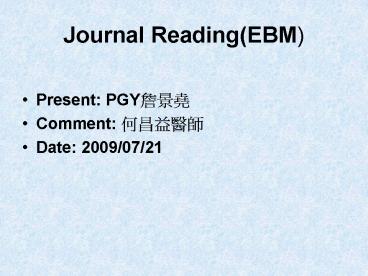Journal ReadingEBM PowerPoint PPT Presentation
1 / 22
Title: Journal ReadingEBM
1
Journal Reading(EBM)
- Present PGY???
- Comment ?????
- Date 2009/07/21
2
Problem solve byEvidence Base medicine
- Problem Does percutanous drainage have a better
outcome compared with surgical drainage of renal
abscess?
3
- Problem Patient with renal abscess
- I use percutaneous drainage
- C use surgical surgery
- O prognosis of patient with renal abscess
4
Search Terms Strategyrenal abscess
percutaneous drainage with Pubmed
5
(No Transcript)
6
(No Transcript)
7
SEARCH STRATEGY
- Citation
- Immediate percutaneous drainage compared with
surgical drainage of renal abscess - Journal Int Urol Nephrol (2007) 395155
- Lead author's name
- Ching-Hui Hung A Jyh-Dar Liou A
- Meng-Yi Yan A Chia-Chu Chang
- Study Selection
- Type retrospective cross-section study
- Level 2b
8
Introduction
- Renal abscesses have been associated with
significant mortality ranging from 39 to 56,
despite aggressive surgical drainage - Salvatierra O, Bucklew WB, Morrow JW (1967)
Perinephric abscess a report of 71 cases. J Urol
98296302 - With the availability of computed tomography (CT)
scanning for percutaneous drainage procedures in
renal abscess, mortality has been reduced to 12 - Meng MV, Mario LA, McCanich JM (2002) Current
treatment and outcomes of perinephric abscesses.
J Urol 16813371340
9
Introduction
- Either percutaneous catheter or surgical drainage
may be indicated in the case of large
pus-containing cavities - Deyoe LA, Cronan JJ, Lambiase RE et al
(1990) - Percutaneous drainage of renal and perirenal
abscesses results in 30 patients. Am J
Roentgenol 1558183 - The cure rate after treatment with routine
antibiotics plus percutaneous drainage has had
the most favorable outcome of renal abscesses - Yen DH, Hu SC, Tsai J, Kao WF et al (1999)
Renal abscess early diagnosis and treatment. Am
J Emerg Med 17192197
10
Material and method
- Patients with renal abscess treated at Changhua
Christian Hospital from January 2000 to December
2004 were enrolled. - The diagnosis of renal abscess was confirmed via
the combination of CT scan and microbiologic
study. - Drainage was recommended to patients with
puscontaining cavities greater than 3 cm.
11
Material and method
- Immediate percutaneous catheter drainage
- was performed for patients with pus-containing
cavities greater than 3 cm who consented in - the emergency section.
- Without consent for immediate percutaneous
catheter drainage, we performed surgical drainage
for these in-patients who had pus-containing
cavities greater than 3 cm.
12
Material and method
- Age, white blood cell count, C-reactive protein
level, presence of SIRS, MODS, predisposing
factors, abscess size, and bacteriological
factors were all analyzed. - The non-parametric test was the statistical
- method used in our study for comparing the two
- groups. A P value lt 0.05 was considered
significant.
13
Result
14
Result
15
Result
- All patients were treated with intravenous
antibiotics for a mean duration of 11 days. - There was no significant difference between the
two groups (P 0.1480) about the hospital
course. - The mean CRP level in PCD (mean 136.7 63.7
mg/l) patients who died of multiple organ failure
was 200 mg/l and in the surgical drainage group
(mean 176.7 70.3 mg/l) was 206 mg/l.
16
Result
17
Discussion
- In our study, percutaneous drainage or surgical
drainage in patients with similar clinical
characters upon arrival at the emergency division
had comparable outcomes, such as duration of
hospitalization and survival. - We demonstrated that larger abscess size and
higher CRP levels appeared to determine prognosis
in patients with renal abscess.
18
Discussion
- Complete drainage of purulent collections remains
the most important principle in successful
outcomes of larger abscesses, which can typically
be achieved percutaneously. - Outcome variables have included abscess size,
daily drainage volume and location, presence of a
gastrointestinal fistula, age, bacteriologic
factors, and pulse rate, body temperature, and
leukocyte count. - Brolin RE, Flancbaum L, Ercoli FR et al
(1991) Limitations of percutaneous catheter
drainage of abdominal abscesses. Surg Gynecol
Obstet 173203210
19
Discussion
- The advantages of percutaneous abscess drainage
include simple, rapid performance feasibility of
bedside intensive care unit (ICU) performance
safety avoidance of general anesthesia and
welldocumented efficacy. - Kerlad RK Jr, Pogany AC, Jeffrey RB et al
(1985) Radiologic management of abdominal
abscesses. Am J Roentgenol 144145149 - Early recognition of renal abscess and prompt
drainage, either percutaneously or surgically, in
combination with appropriate antibiotic coverage,
should dramatically reduce morbidity and
mortality from this infection. - Hutchison FN, Kaysen GA (1988) Perinephric
abscess - the missed diagnosis. Med Clin North Am
729931014
20
Conclusion
- Despite, bacteria with more resistant strains
(data not shown) and more patients with multiple
organ dysfunction syndromes, Patients treated
with percutaneous drainage for renal abscess
still had outcomes comparable to those treated
with surgical drainage. - As previously reported, we found that diabetes
mellitus and nephrolithiasis were the leading
underlying diseases in patients with renal
abscess. - Abdul-Halim H, Kehinde EO, Abdeen S et al
(2005) Severe emphysematous pyelonephritis in
diabetic patients diagnosis and aspects of
surgical management. Urol Int 75123128
21
Conclusion
- In conclusion that based on retrospective and
non-randomized analysis, renal abscess may
present a variable clinical picture and
percutaneous drainage was done on all who
consented. - Both percutaneous drainage and surgical drainage
for renal abscesses had a favorable outcome.
22
- Thanks for your attention

